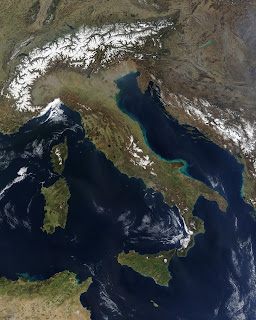With that being said, Italy lies right at the meeting points of the Eurasian and African tectonic plates. These plates clash together and cause subduction right along the middle of the country. This creates the mostly sedimentary Apennine Mountains. These mountains are sometimes called the Italian Backbone because they span the length of the country.
Apennine Mountains
Parts of the Apennines are made from volcanic activity. When looking at the rock formations we can see huge chunks of basalt.
Basalt Pillows
There are about 29 volcanoes in Italy, out of all of them, there are still 3 active volcanoes, and 3 volcanoes, with reported, but not confirmed activity in previous years. The most famous of Italy's active Volcanoes is Mount Vesuvius. Mount Vesuvius is an andesite, or composite volcano with a large and deep caldera which formed approximately 17,000 years ago after a massive explosion. Even though the volcano does little more than spout steam and gases, it is rich with potassium and phonolite, causing extreme explosions.
 |
| 1944 Eeruption |
 |
| Satellite View |
 |
| Vesuvius Today |
 |
| Stromboli Volcano off of Sicily |
When looking at other rock formations like the gorgeous plateau, Pietra di Bismantova, scientists had discovered that this area used to be underwater and rose up out of the sea. Fossils can be found on the peaks, and the rocks matches those that had been found in the sea. The area used to be, at one point, in the lush tropical waters, as suggested by the fossils found. It almost looks like a hogback but I don't believe it is.
Pietra di Bismantova
Tying back into the clashing of the tectonic plates however, some cities, such as Pisa, aren't exactly suitable for construction. The Leaning Tower of Pisa, was once straight, but due to liquefaction, part of the tower began to sink into the ground. Liquefaction is was the ground is really sandy and has just enough water under and in it to slowly pull things down. Quicksand is a keep form of liquefaction.
Leaning Tower of Pisa
When the plates crash together, the earthquakes shake up the soft sandy ground with the water and cause the ground to sink down in the areas around the earthquake. Such as during the earthquake that occurred in Italy last May where the streets began to sink in the sand.
The grounds aren't exactly stable and the the plates colliding isn't a good thing, but it still is a very beautiful place to live.








